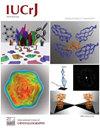利用量子晶体学和静电相互作用能了解非甾体抗炎药对环加氧酶的选择性。
IF 3.6
2区 材料科学
Q2 CHEMISTRY, MULTIDISCIPLINARY
引用次数: 0
摘要
量子晶体学方法被用于研究非甾体抗炎药(NSAIDs)和环氧化酶(COX)酶之间的复合物形成,特别是COX-1和COX-2亚型。本研究分析了选定的非甾体抗炎药(氟比洛芬、布洛芬、美洛昔康和塞来昔布)与COX-1和COX-2活性位点的静电相互作用能,发现它们的结合谱存在显著差异。氟比洛芬与COX-1和COX-2均表现出最强的相互作用,表明其具有强大的结合亲和力。塞来昔布和美洛昔康表现出对COX-2的偏好,这与它们对COX-2亚型的已知选择性一致,而布洛芬与这两种亚型的相互作用能相当,反映了其非选择性抑制模式。关键氨基酸残基,包括Arg120, Arg/His513和Tyr355,被确定为NSAID选择性和结合亲和力的关键决定因素。这些发现强调了相互作用能和选择性之间复杂的相互作用,表明静电相互作用在非甾体抗炎药的治疗效果和安全性方面起着重要作用,酶动力学和疏水效应等其他因素也起着重要作用。这些见解为非甾体抗炎药的合理设计提供了有价值的指导,以提高治疗效果和最小化不良反应。本文章由计算机程序翻译,如有差异,请以英文原文为准。
Understanding the selectivity of nonsteroidal anti-inflammatory drugs for cyclooxygenases using quantum crystallography and electrostatic interaction energy
This study employs quantum crystallography to elucidate the selectivity of nonsteroidal anti-inflammatory drugs (NSAIDs), including ibuprofen, flurbiprofen, meloxicam and celecoxib, for cyclooxygenase-1 and cyclooxygenase-2 enzymes by analyzing binding energy and electrostatic interactions. The findings reveal key structural determinants of NSAID selectivity, providing valuable insights for the rational design of safer and more effective anti-inflammatory drugs.
Quantum crystallography methods have been employed to investigate complex formation between nonsteroidal anti-inflammatory drugs (NSAIDs) and cyclooxygenase (COX) enzymes, with particular focus on the COX-1 and COX-2 isoforms. This study analyzed the electrostatic interaction energies of selected NSAIDs (flurbiprofen, ibuprofen, meloxicam and celecoxib) with the active sites of COX-1 and COX-2, revealing significant differences in binding profiles. Flurbiprofen exhibited the strongest interactions with both COX-1 and COX-2, indicating its potent binding affinity. Celecoxib and meloxicam showed a preference for COX-2, consistent with their known selectivity for this isoform, while ibuprofen showed comparable interaction energies with both isoforms, reflecting its nonselective inhibition pattern. Key amino-acid residues, including Arg120, Arg/His513 and Tyr355, were identified as critical determinants of NSAID selectivity and binding affinity. The findings highlight the complex interplay between interaction energy and selectivity, suggesting that while electrostatic interactions play a fundamental role, additional factors such as enzyme dynamics and the hydrophobic effect also contribute to the therapeutic efficacy and safety profiles of NSAIDs. These insights provide valuable guidance for the rational design of NSAIDs with enhanced therapeutic benefits and minimized adverse effects.
求助全文
通过发布文献求助,成功后即可免费获取论文全文。
去求助
来源期刊

IUCrJ
CHEMISTRY, MULTIDISCIPLINARYCRYSTALLOGRAPH-CRYSTALLOGRAPHY
CiteScore
7.50
自引率
5.10%
发文量
95
审稿时长
10 weeks
期刊介绍:
IUCrJ is a new fully open-access peer-reviewed journal from the International Union of Crystallography (IUCr).
The journal will publish high-profile articles on all aspects of the sciences and technologies supported by the IUCr via its commissions, including emerging fields where structural results underpin the science reported in the article. Our aim is to make IUCrJ the natural home for high-quality structural science results. Chemists, biologists, physicists and material scientists will be actively encouraged to report their structural studies in IUCrJ.
 求助内容:
求助内容: 应助结果提醒方式:
应助结果提醒方式:


